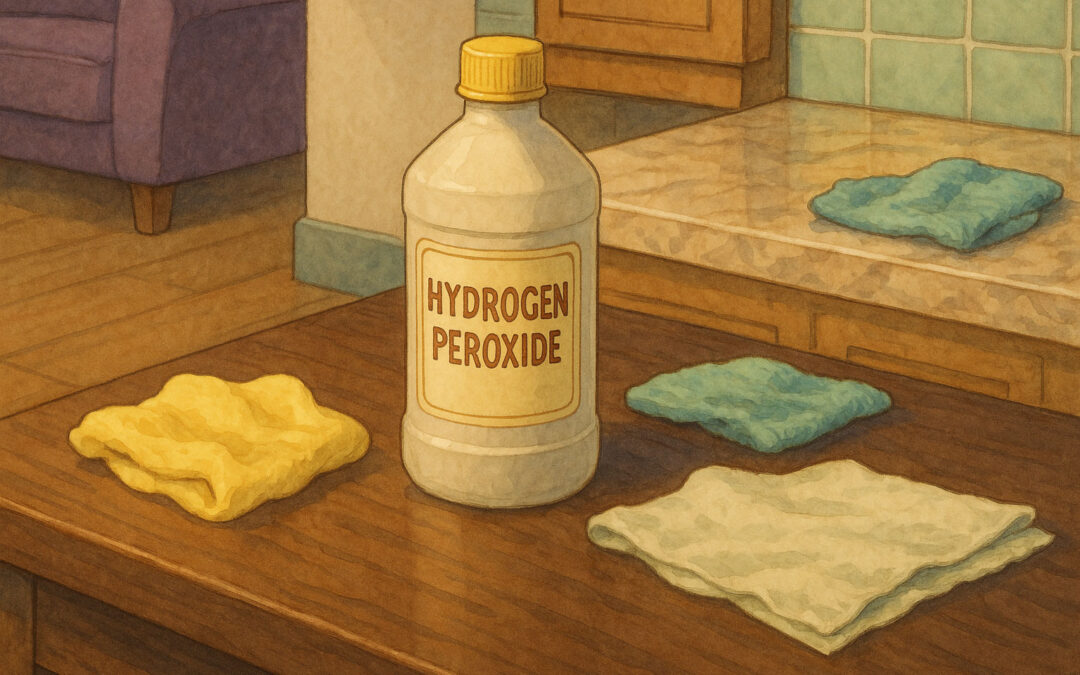At Tidy Casa, we clean over 600 homes a month here in Phoenix and Tucson, so we’ve seen a lot. We’ve also tested just about every cleaning product out there—some winners, some… not so much.
Hydrogen peroxide is one of those cleaners that feels like it should work on everything. It’s cheap, it bubbles up like it’s doing something impressive, and it has that “science class magic” vibe. But here’s the thing: just because it can clean something doesn’t mean it should.
We’ve made some mistakes with it. Costly ones. So if we can help you avoid a bleachy disaster, we’re happy to.
Here’s a quick guide to what you should never clean with hydrogen peroxide, and what to use instead.
1. Natural Stone (Granite, Marble, Quartz)
Hydrogen peroxide and natural stone do not get along. It can break down the sealant, dull the finish, and even cause etching. Think: cloudy spots and weird streaks on what used to be your shiny countertop.
🔥 We had a cleaner use it on granite once. Let’s just say it was a very expensive training moment.
Use instead:
Stick with a pH-neutral stone cleaner or a bit of mild dish soap and warm water. That combo is boring—but safe and effective.
2. Wood Floors and Furniture
Wood is a little dramatic when it comes to harsh cleaners, and hydrogen peroxide is no exception. It can bleach the wood or eat through the finish, especially if you don’t wipe it up fast.
One second you’re spot-cleaning a scuff, the next you’ve got a pale ghost-shaped patch that haunts your hardwood.
Use instead:
Go with a wood-safe cleaner, or a gentle mix of vinegar and water (just make sure the wood’s sealed). And please, dry it immediately.
3. Colored Fabric or Upholstery
Hydrogen peroxide is a mild bleach—which is fine if you’re treating white socks or blood stains on a mattress. But on your couch, your curtains, or that fancy throw pillow you got on Etsy? Bad idea.
Unless you’re into surprise tie-dye patterns, skip it.
Use instead:
Try a color-safe stain remover, or a homemade paste of baking soda and dish soap. For pet accidents or wine spills, an enzyme-based cleaner is the MVP.
4. Bonus Round: Other Places to Skip
Here are a couple more places peroxide doesn’t belong:
-
Aluminum: It reacts and can discolor the metal. No one wants splotchy pots or weird stains on fixtures.
-
Electronics (screens, keyboards, phones): Way too harsh. It can damage coatings and sensitive parts. Don’t ask how we know.
Use instead:
-
For electronics: a microfiber cloth with a little isopropyl alcohol (70%).
-
For aluminum: dish soap, warm water, and maybe some baking soda if things are really crusty.
Final Thoughts: Use It… Sometimes
Hydrogen peroxide is one of those tools you want in your cleaning kit—but not everywhere. It’s like that friend who’s awesome at karaoke but should not be in charge of the playlist.
So here’s the rule: when in doubt, don’t bust out the peroxide. Test it first, or just give us a call. We’ve already made the mistakes so you don’t have to.
Need help cleaning the right way (with the right stuff)?
We’ve got your back—book a cleaning with Tidy Casa, and we’ll make your home shine without bleaching your floors or bubbling your countertops.
📞 Call us: (602) 753-5630
📧 Email: support@tidycasa.com
🌐 tidycasa.com
A home cleaning/maid service in Phoenix and Tucson, AZ.

